Competitor Analysis Framework – A Definitive Guide [From A Marketing Standpoint]
![Competitor Analysis Framework – A Definitive Guide [From A Marketing Standpoint]](https://skalegrow.com/wp-content/uploads/2024/12/Featured-Images-1-2-1024x576.png)
Competitor analysis is a very broad area. Depending on the objective of your analysis, the data points you collect will vary.
When it comes to marketing, however, it is possible to create a framework or structure for doing competitor analysis – which is what I intend to cover in this article.
As always, since I wanted to make the content more valuable to you, I have taken a real company called Red Stag Fulfillment (RSF) as an example and done the competitor analysis using the steps I mentioned in the framework. I have skipped the sample competitor analysis for a few steps as it would make the article too lengthy.
That said, let’s get started.
Clearing the misconceptions about competitor analysis
One of the most common misconceptions of competitor analysis is that you need to do it only during a product launch or devising a go-to-market strategy. However, I believe that it is a frequent activity that you should perform at least once a quarter. It helps in the following ways:
- Realign your positioning, messaging, and targeting strategy.
- Refine your content marketing strategy based on what your competitor is doing.
- Identify new marketing tactics.
Another common notion is that competitor analysis is only meant to be performed in connection with the overall business strategy formation. Except for ad-hoc activities, I don’t see many B2B marketing teams doing regular competitor analysis in an organized manner. This also needs to change.
With these in mind, let us look at the comprehensive approach to doing competitor analysis from a marketing standpoint.
Competitor analysis framework for B2B marketers
Here are the elements of the competitor analysis framework for B2B marketers:
- Business overview – products/services, key customers & partners, target segments, etc.
- Marketing overview – a quick overview of key marketing metrics at a business level
- Positioning, value proposition, and messaging
- Website traffic analysis
- SEO audit
- Content audit – blog, videos, gated assets.
- Social media audit
- Ads analysis
- Marketing tech stack analysis
- Email marketing audit
- Website chat analysis
- Online and offline event analysis
- Analyzing other online activities
1. Business overview – the heart of the competitor analysis framework
The first step to analyzing a competitor is understanding their business. Here are examples of some of the information you would want to collect as a part of this step:
- Firmographic information such as revenue, number of employees, and region – can be obtained using tools like ZoomInfo and LinkedIn (for instance, as per ZoomInfo, RSF – the company we have taken for analysis today – has a revenue of $15.6M).
- All elements of the go-to-market (GTM) strategy such as target markets, products/solutions, launch plans, channel strategy, etc. Details of the competitor’s target market and products/solutions can be obtained from their website. We will discuss how to collect details of the other GTM items (like channel strategy) in some of the upcoming sections.
- A list of customers and partners – can be obtained from the website.
- Leadership team – can be obtained from the website/LinkedIn.
There are more elements to understanding a business. But for the purpose of a marketing-oriented analysis, these details would suffice.
Also read: The GTM Flywheel – Go To Market Strategy For New-age B2B Businesses
2. Marketing overview
Just like we did the business overview, there are a few metrics and details you can look at to get a quick overview of a company’s marketing strength. They include:
- Number of webpages (you can get this info by using the ‘site:domain.com’ command in Google search. For example, RSF has 1030 pages).
- Number of resources such as blog posts, videos on the website, case studies, whitepapers, ebooks, etc (you will have to take this out by manually counting them on the website).
- YouTube data such as the number of videos and the number of subscribers (RSF’s YouTube channel has 16 videos and 209 subscribers).
- LinkedIn data: number of followers, frequency of posting, the average number of reactions, etc (RSF has 4129 followers on LinkedIn at the time of writing this article). If interested, you can also look at the company’s presence on other social media platforms like X and Facebook.
These pieces of information will help you get a sense of how actively invested your competitor is in marketing.
3. Positioning, value proposition, and messaging
This is a qualitative analysis. Following are the places/content items where you can get a view of what the company is focusing on in terms of its positioning, USPs, and messaging:
- Website copy and content
- Videos
- Leadership talks
- Press releases and magazine coverages
- Webinars
Though there are plenty of ways to collect this info, you don’t have to overdo it. If you are experienced enough, you should be able to get the necessary information by looking at the website copy and a couple of other content pieces.
Related: Webinar Marketing – Everything You Need To Know
4. Website traffic analysis
We will dive deep into website traffic analysis since this is one of the areas that can give you a ton of insights into what your competitor has managed to achieve in comparison with your business. We will be using the tool Similarweb to do competitor website analysis.
Following are the data points related to the website we will take out for RSF:
- Traffic overview
- Traffic growth over time (last three months)
- Channel-wise website traffic
- Country-wise website traffic (top countries)
The following screenshots showcase these values (all data points are for the period Dec to Feb 2024):
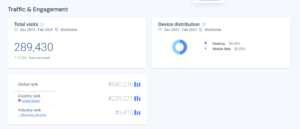
RSF – traffic overview
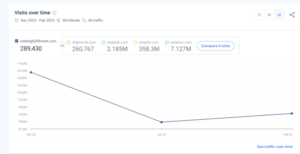
RSF – traffic change over the last 3 months
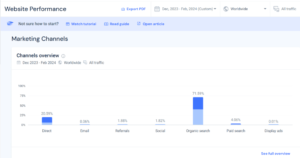
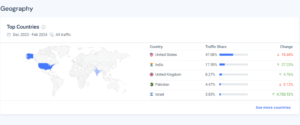
5. SEO audit
Given that this exercise aims to know how your competitors are doing in terms of marketing and what you can learn from them, we shall be able to limit our SEO analysis to the following:
- SEO overview – metrics like domain rating, number of backlinks, number of organic keywords, etc. You can use any SEO tool like SEMRush or Moz for this. For analyzing RSF (screenshot attached below), I have used Ahrefs.
- Top organic keywords: this will help you understand the keywords your competitor’s website is ranking for.
- Top pages: this is to learn which of your competitor’s pages are ranking well. You can then go look at those pages to collect information like keywords, metatag design, page structure, etc., to see if there is something you could learn from it.
- Top competing domains: this is not a must, but more like a good-to-do activity. Since your competitor is also in the same space as you are, looking at competing domains is most likely going to show a list of websites that you are already familiar with. However, it can so happen that you identify a new competitor or a website that is taking a share of the traffic in your space (bonus tip: you can repeat this exercise for your website and other competitor websites to identify more such competing domains).
Given below are the screenshots of the above four parameters for RSF:

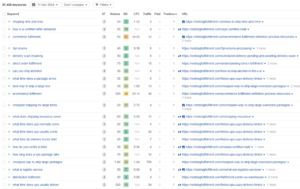

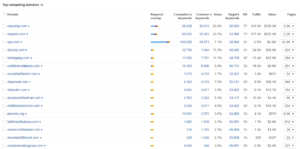
6. Content audit as a part of the competitor analysis framework
A content audit involves analyzing your competitors’ content types, publishing frequency, content strategy for campaigns, and a lot more. It wouldn’t be possible to cover everything in this article. But for this analysis, here are the pieces of information you can collect:
- Content types your competitor is creating – such as blog posts, whitepapers, videos, case studies, ebooks, podcasts, newsletters, etc.
- Number of items published in each content type.
- The tone, positioning, and messaging reflected in the content.
Since our objective is also to look for things we can ‘steal’ from the competition, you can carry out something called a content gap analysis.
A content gap analysis is the exercise of identifying potential content ideas by comparing your website with that of your competitor. Broadly speaking, it could apply to any type of content. But it is usually used for website content – in particular blogs.
The result of the analysis is a set of keywords around which you can start creating content.
You can carry out this analysis by using any of the popular SEO competitor analysis tools. Here is the screenshot of the results I obtained from Ahrefs while doing content gap analysis for RSF (here, please note that I have taken RSF as the base website and a couple of its competitors as the comparison website. While doing it for your business, make sure to enter your competitor’s domains in the target section):
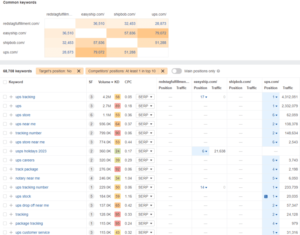
7. Social media audit
Social media competitor analysis is pretty straightforward. Here, you simply look at the social media accounts of your competition and derive insights about:
- Number of followers
- Frequency of posting content
- Types of posts published
- Average engagement on posts
For B2B businesses, LinkedIn is the best or at least the first place where you should do this research. Depending on your niche, you can do the same for Facebook, Twitter, or any other social media that you think is relevant.
[Bonus tip: If you are using a social listening tool like Brandwatch, Mention, Meltwater, or any tool of that kind, you can leverage them to do detailed research on your competitor’s social media presence].
Related: Top B2B Social Media Marketing Trends For 2024
8. Ads analysis
One of the best ways to understand your competitors’ marketing strategy is to analyze their paid campaigns across platforms. You can do this by looking up the ads on individual platforms like LinkedIn, Facebook, and Google ads (through region-wise google search).
But that’s a time-consuming process and doesn’t give you a consolidated view of ads running across platforms. This is where you need to use an ad search engine like Moat or Adbeat.
To help you understand this better, here is a screenshot from Adbeat that gives an overview of all ads run by Freshworks (I have taken Freshworks as an example since RSF is not running any ads currently):
![7. Social media audit Social media competitor analysis is pretty straightforward. Here, you simply look at the social media accounts of your competition and derive insights about: Number of followers Frequency of posting content Types of posts published Average engagement on posts For B2B businesses, LinkedIn is the best or at least the first place where you should do this research. Depending on your niche, you can do the same for Facebook, Twitter, or any other social media that you think is relevant. [Bonus tip: If you are using a social listening tool like Brandwatch, Mention, Meltwater, or any tool of that kind, you can leverage them to do detailed research on your competitor’s social media presence]. Related: Top B2B Social Media Marketing Trends For 2024 8. Ads analysis One of the best ways to understand your competitors’ marketing strategy is to analyze their paid campaigns across platforms. You can do this by looking up the ads on individual platforms like LinkedIn, Facebook, and Google ads (through region-wise google search). But that’s a time-consuming process and doesn’t give you a consolidated view of ads running across platforms. This is where you need to use an ad search engine like Moat or Adbeat. To help you understand this better, here is a screenshot from Adbeat that gives an overview of all ads run by Freshworks (I have taken Freshworks as an example since RSF is not running any ads currently):](https://skalegrow.com/wp-content/uploads/2024/12/Ads-overview-Freshworks-1024x445-1-300x130.png)
The screenshot only shows an overview. You can go to individual tabs to get a detailed view of all the ads.
9. Marketing tech stack analysis
This is my personal favorite, given that I am a martech enthusiast. There are a couple of ways in which you can find out the marketing tools a company is using (both of which are free):
- If you are a techie and know how to read the website’s code, you can look at the competitor’s home page code and figure out the tools they are using by identifying the tracking codes on the page.
- The second and a ‘non-techie’ method is to use an automated website code analyzer like Builtwith.com. With Builtwith.com, you can get a list of all the tools (of course, for those which tracking code is added on the webpage) a website is using by simply putting in the URL.
Here is the screenshot that gives a snapshot of RSF’s martech stack:
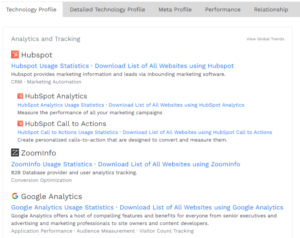
Also read: How To Build A Lean B2B Martech Stack For Demand Generation
10. Email marketing audit
Analyzing your competitor’s email marketing strategy requires a sneaky approach (don’t worry, it’s not illegal
- The first one is to use a personal email ID (or a business email ID that wouldn’t associate you with your core business) to sign up for the competitor’s email. This way, you will get to see all the emails your competitors are sending. There will be a ton of valuable insights you can get from this.
- The second and more effective method is to use an email monitoring and tracking tool like SendView. SendView allows you to create a private tracking email ID which helps mask your identity. The tool also gives you other information like the ESP (Email Service Provider) of the competitor, their spam score, word count & subject line length (for an individual email), etc.
11. Website chat analysis
Finding more about a company’s chat strategy also requires a kind of sneaky tactic. During the martech analysis (step 9 of this article), you would have identified the chat tool they are using if any. This is the first step (as such this information is not that valuable. But this will be a great input if you are considering to evaluate a chat tool for your own website).
Now, the sneaky tactic I am talking about is to go and use the chat window (of course, without identifying yourself). By doing this, you will be able to collect vital information like:
- the speed of response or turnaround time of the competitor’s customer support team.
- the quality and nature of their response (there might be things that you can learn here).
- any chat automation workflows they have implemented.
- if there is automation in place, the way in which they have organized different automated responses.
12. Online and offline event analysis
Given that businesses have started getting back to events post covid, knowing about your competitors’ event plans is a good way to get a view into their marketing strategy.
Most companies will list their upcoming and concluded events on the website under the events section. This is a place where you can get updates on both online and offline events.
For online events, you can also look at the events tab of the company’s social media profiles (or even the personal profiles of the events manager or head of marketing working at the company).
When it comes to offline events particularly, in addition to what I have mentioned above, you can use the following steps to figure out which ones your competitors are exhibiting in (this method works only if your competitor is setting up a booth at the event, or if anybody from their side is a speaker or panelist at the event):
- Identify the most popular events in your industry that you and your competitors would usually be a part of.
- Most of the companies that host these events publish the list of exhibitors and speakers on their website a few weeks (or sometimes months) in advance. Check if any of your competitors are a part of the list.
- On the day of the event, if you are also exhibiting at or attending the event, make sure to check out their presence at the venue (be it their booth or any other type of involvement).
If the event host has not published the information on their website, you can get in touch with them expressing interest in exhibiting at the event even if you don’t intend to (a bit sneaky. Some might say unethical. But it’s up to you to decide if you want to do this). Then you can ask who else from your industry is taking part in the event. Mostly the person on the other side will be open to sharing this information.
Related: 1+1 growth hacks exclusively for in-person events
13. Analyzing other online activities
This is more qualitative and requires slightly more effort compared to the other steps. This is because there is no organized way of doing this. Nor there is a single tool or platform that will give you all of the data in one place.
What I am referring to when I say ‘other online activities’ are the following:
- Third-party ad campaigns run by your competitors – these are ads run on media websites that have an audience in your niche. An example of this is Clutch.co. It’s a B2B ratings and reviews website where you can also run paid promotions. Ads can be in the form of banner ads, newsletter blasts, whitepaper campaigns, or even sponsored webinars.
- Press releases (either on the company website and/or on popular PR websites like PR Web).
- Leadership branding – this is where the company encourages its employees and leaders to build a personal brand around the business’ niche. You can collect this information by looking at the personal LinkedIn profiles of the senior leaders (mostly C suite) of the competitor. Look for activities like organic social posting, podcast appearances, speaking gigs, etc.
- Online forums and communities – usually, you can figure this out only if you are also a part of the communities where your competitors are present.
[Note: Do give this a thought and add more ‘other online activities’ specific to your business].
Final words about the competitor analysis framework
Competitor analysis many a time is an activity that is done once and forgotten. It also happens that many companies don’t even use the insights they get from the analysis to the business’ advantage – especially in marketing. Don’t be one of those. Use the framework I discussed and prepare yourself to jump ahead of your competition.
That’s all I wanted to cover today.
Looking to grow your B2B business with marketing? Try Skalegrow
With marketing getting tougher and tougher, every wrong foot you make might hamper your growth. What you need is the right guidance and a helping hand. This is where Skalegrow can make a sea of difference.
Skalegrow helps IT, tech, SaaS, and embedded systems companies leverage new-age marketing tactics to grow their business. Check out the below intro video to learn more about what Skalegrow brings to the table:
Alternatively, you can visit our services page or write to us at info@skalegrow.com.
About the author

Naseef KPO is the Founder and CEO of Skalegrow. He comes with rich experience across multiple areas of B2B marketing including content marketing, demand generation, SEO, account based marketing, marketing analytics, revenue attribution, marketing technology, etc. He writes thought-provoking and relevant articles on The Skalegrow Blog and his weekly LinkedIn newsletter Elevate Your Marketing.
Prior to starting Skalegrow, Naseef led large marketing teams in multi-million dollar B2B organizations where he made significant contributions to the topline growth of the business. He has also appeared on numerous podcasts where he shared his thoughts on trending marketing topics such as the application of AI in marketing, startup marketing, ABM, and B2B content marketing, just to name a few. Being the founder of Skalegrow, he is currently focusing on helping its clients stay ahead of their competition by using innovative yet practical marketing tactics.
You can connect with Naseef KPO on LinkedIn.

John Doe
Habitant morbi tristique senectus et netus et malesuada fames ac turpis egestas. Nullam vehicula eros in suscipit fringilla. Aenean quis ex hendrerit, fringilla diam egestas, hendrerit nunc. Nunc at egestas magna. Nullam eu tempus ipsum. Pellentesque arcu mi, condimentum sit amet tincidunt eget, tristique sed turpis. Cras tempor mollis ultrices.






![How To Craft A Cold Email Sequence That Works [With Examples]](https://skalegrow.com/wp-content/uploads/2024/12/How-To-Craft-A-Cold-Email-Sequence-1024x576.png)


 your marketing
your marketing  new-age tactics?
new-age tactics?